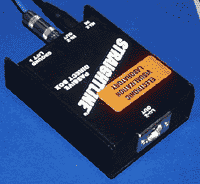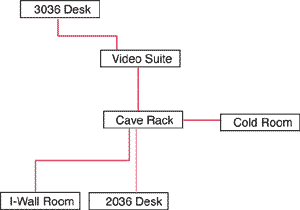There are a few things you need to know about signal types. First off, there are 2 main analogue signals you'll be working with. Line leve, and mic level. Line level has more juice, its a lot louder, and if you send it into a mic input, you'll get distortion. Mic levels need to be amplified with a pre-amp, otherwise in a line level input, they're too quiet.
Another important distinction is cable type. We use two types of cabling, balanced and unbalanced. Balanced signals travel down three wires, a positive, negative and a ground. The benefit of this setup is the resistance to interferance. Unfortuately, most standard computer audio cards use unbalanced signals. These run on just two lines, a positive and a negative. You can't run unbalanced lines very far (especially in a computer lab) without picking up tons of noise and crap on the line.
The way we deal with this problem is to use a direct box. This box converts unbalanced signals to balanced signals that can travel all over the lab without much interference.
To see a listing of what kind of signals run on what lines and connetors, go to the connectors page.

A Direct Box
Here at EVL we need
to run lots of audio signals to different places all the time. The best
way to do this is with Patchbays (or Patch Panels) these rack units are
set up in the cold room, cave rack, edit suite, 2036 I-desk, Eye-vall
room, and 3036 I-desk. By reading the lables, you should be able to figure
out how to connect audio from any one of those places to any other.
Below is a map of how the patchbays are wired at EVL.


Typical Switchcraft 1/4" TRS patchbay